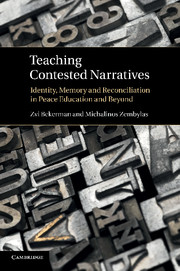Book contents
- Frontmatter
- Contents
- Acknowledgments
- Permissions
- Part I Introduction and theoretical underpinnings
- 1 Introduction
- 2 Problematizing peace education romanticism
- 3 On conflict, identity and more
- Part II Living and teaching contested narratives
- Part III Mourning, forgiveness and reconciliation
- Part IV Conclusions
- References
- Index
1 - Introduction
Published online by Cambridge University Press: 05 December 2011
- Frontmatter
- Contents
- Acknowledgments
- Permissions
- Part I Introduction and theoretical underpinnings
- 1 Introduction
- 2 Problematizing peace education romanticism
- 3 On conflict, identity and more
- Part II Living and teaching contested narratives
- Part III Mourning, forgiveness and reconciliation
- Part IV Conclusions
- References
- Index
Summary
It would be really nice if conflict was a “thing” that, given the proper conditions, could be overcome or even erased. It would be even nicer if peace was also a “thing” that, given the proper conditions, could be reached. If one looks at what is occasionally suggested in the fields of peace studies and conflict resolution, one might get the impression that indeed peace and conflict are reachable and/or erasable “things.” These representations of peace and conflict have certain consequences in terms of our (in)ability to envision and enact particular solutions as responses to conflict – not only in society but also in educational settings. Ultimately, it is this that we want to talk about in the present book.
The prime aim of this book is to offer a social and anthropological perspective on the theoretical underpinnings and practical implications of peace education efforts in troubled societies, that is, societies in which there is some form of conflict (armed, political, cultural and so on). This book raises questions about the psychologized grounding of many peace education interventions within a nation-state framework that is taken for granted. It explores how our framing of the “problem” limits our vision for “solutions” to conflict. Central to our analysis are the ways in which notions of identity, memory and reconciliation are entangled and perpetuate or challenge the depth of attachment to essentialist ideas about peace and conflict.
- Type
- Chapter
- Information
- Teaching Contested NarrativesIdentity, Memory and Reconciliation in Peace Education and Beyond, pp. 3 - 23Publisher: Cambridge University PressPrint publication year: 2011



